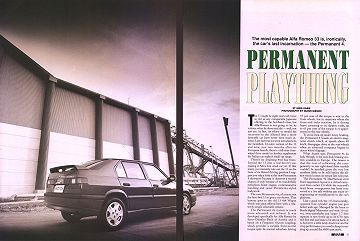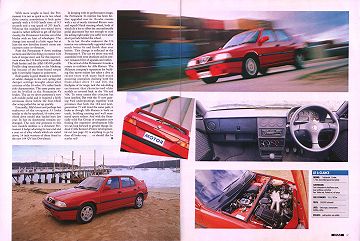Permanent Plaything — Motor Magazine
Published: June 1991
Author: Greg Kable
Publication: Motor (Pages 64-67)
The most capable Alfa Romeo 33 is, ironically, the car’s last incarnation — the Permanent 4.
The 33 might be eight years old, twice as old as any comparable Japanese offering in the hot-hatch class, but Alfa Romeo is not going to let its volume seller lie down and die — well, not just yet. In fact, its efforts to mould the successor to the Alfasud into a more desirable car have never been more intense. Late last year we were introduced to the facelift, 16-valve version of the 33 and now, just two months after its European launch, there’s a full-time four-wheel drive model to further supplement the Italian car maker’s small car range.
There’s no doubting 4wd has trans-formed the 33 into a real driver’s car, making it Alfa’s best small car yet. If, like many, you instantly rule out the 33 on the basis of its flawed driving position I suggest you take a look at this new Permanent 4 derivative because it deserves a second chance, if only because of its wonderfully melodious boxer engine, communicative handling and sweet Pininfarina-styled bodywork.
The new Permanent 4 is, of course, not the first 4wd 33 to grace our shores. That honour goes to the old 33 4x4 Wagon which was once offered here with a relatively simple selectable system.
The Permanent 4’s system is much more advanced and refined. It was developed specifically for Alfa Romeo by Steyr-Daimler-Puch of Austria and is based on a Ferguson viscous coupling, which provides a variable front-to-rear torque split. In normal suburban driving 95 per cent of the torque is sent to the front wheels, but in situations where the front-end lacks traction, be it during heavy cornering or on slippery roads, up to 65 per cent of the torque is re-apportioned to the rear wheels.
To avoid lock-up under heavy braking, the Permanent 4 boasts an electro-magnetic clutch which, at speeds above 48 km/h, disengages drive to the rear wheels when an advanced computer begins to detect wheel slippage.
What Aussie spec Permanent 4s do lack, though, is the anti-lock braking system available in Europe. The reason is that the cost of relocating the componentry to suit right-hand drive models couldn’t be justified given the very low numbers likely to be sold before the all-new model comes on stream late next year.
The Permanent 4’s McPherson strut front suspension layout is a virtual carry-over from earlier 33s while the rear-end’s dead beam arrangement has been converted to a live axle without any major re-engineering or modifications to the car’s platform.
Like a good red, the 33’s horizontally-opposed four-cylinder engine just gets better with age. Managed by the latest in Bosch digital Motronics and with 16-valves, twin-camshafts and larger 1.7-litre capacity it revs freely up to its 6750 rpm red-line and just begs to be driven hard. It is, however, a little tardy down low and for crisp performance you need to keep it running up around the 4000 rpm mark.
With more weight to haul, the Permanent 4 is not as quick as its two wheel drive cousin; nonetheless it feels quite spritely with a 0-100 km/h time of 8.5 seconds and a top speed of 203 km/h. Whereas the standard two-wheel drive model is rather difficult to get off the line cleanly, the Permanent 4 storms out of the blocks with no hint of wheelspin. The change into second is a little vague but at least the new driveline doesn’t create any excessive noise or vibration.
Punt the Permanent 4 down snaking sections and the first thing you notice is its lack of torque steer, and for this improvement alone the 33’s 4wd system is justified. Push harder and the Alfa’s 185/60 profile Pirellis cling tenaciously to the blacktop; but because of the front-biased torque split it inevitably begins to understeer.
Ride quality is good thanks to a number of subtle changes to the car’s spring and damper settings brought about after criticism of the 16-valve 33’s rather harsh ride characteristics. The same praise cannot be levelled at the Permanent 4’s brakes. The car we drove possessed a very soft middle pedal and it required a fairly strenuous shove before the four-wheel disc setup pulled the car up quickly.
Externally, Alfa’s latest and perhaps last makeover of the evergreen 33 looks similar to the be-spoilered, 16-valve, two-wheel drive model that landed here last year. In fact its sheetmetal remains un-changed. The only real giveaway to this new model’s abilities is a chromed Permanent 4 badge adorning its rear-end and a neat set of alloy wheels which are scaled down, 14 inch versions of those fitted to the new 164 QV.
In keeping with its performance image, the Permanent 4’s interior has been further upgraded over its 16-valve cousins with a set of neatly trimmed Recaro seats and superb Nardi steering wheel, both of which do a lot to offset the uncomfortable pedal placement but not enough to cure the aching right ankle you suffer even after short periods behind the wheel.
In its last 16-valve makeover the 33’s interior was substantially upgraded with a much better fit and finish than ever before. This change is reflected in the Permanent 4. The car we drove was well assembled with even shut-ins and its interior remained free of squeaks and rattles.
The arrival of the Permanent 4 marks a return to tradition for Alfa Romeo. The Milanese company’s reputation for building fine sports sedans has taken a dive in recent years with many hard-nosed motoring journalists claiming both the front-wheel drive 33 and 164, the linchpins of its range, lack the tail-sliding excitement that characterised older models so revered back in the ‘50s and ‘60s. To some extent this criticism has been justified. But with the 33 now gaining 4wd underpinnings together with promises that both the 164 and next-generation 75 will tread the same path, it looks as though Alfa Romeo is back on track, building exciting and well mannered sports sedans. And with the financially solid Fiat Group of companies now footing the expensive development bills we can look forward to greater things. Indeed if Alfa Romeo’s Proteo developmental car is anything to go by then all looks rosy... or should that be scarlet red?

